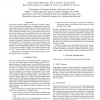Free Online Productivity Tools
i2Speak
i2Symbol
i2OCR
iTex2Img
iWeb2Print
iWeb2Shot
i2Type
iPdf2Split
iPdf2Merge
i2Bopomofo
i2Arabic
i2Style
i2Image
i2PDF
iLatex2Rtf
Sci2ools
118
click to vote
ICASSP
2011
IEEE
2011
IEEE
Deep Belief Networks using discriminative features for phone recognition
Deep Belief Networks (DBNs) are multi-layer generative models. They can be trained to model windows of coefficients extracted from speech and they discover multiple layers of features that capture the higher-order statistical structure of the data. These features can be used to initialize the hidden units of a feed-forward neural network that is then trained to predict the HMM state for the central frame of the window. Initializing with features that are good at generating speech makes the neural network perform much better than initializing with random weights. DBNs have already been used successfully for phone recognition with input coefficients that are MFCCs or filterbank outputs [1, 2]. In this paper, we demonstrate that they work even better when their inputs are speaker adaptive, discriminative features. On the standard TIMIT corpus, they give phone error rates of 19.6% using monophone HMMs and a bigram language model and 19.4% using monophone HMMs and a trigram language mod...
| Added | 21 Aug 2011 |
| Updated | 21 Aug 2011 |
| Type | Journal |
| Year | 2011 |
| Where | ICASSP |
| Authors | Abdel-rahman Mohamed, Tara N. Sainath, George Dahl, Bhuvana Ramabhadran, Geoffrey E. Hinton, Michael A. Picheny |
Comments (0)

